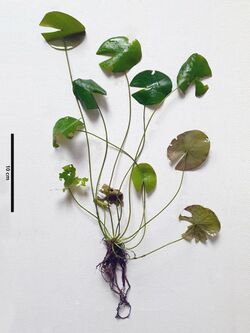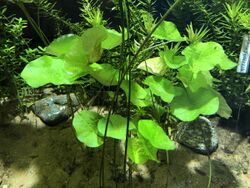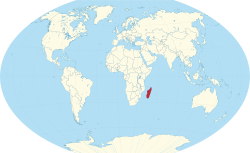Biology:Nymphaea dimorpha
| Nymphaea dimorpha | |
|---|---|

| |
| Nymphaea dimorpha I.M.Turner with scale bar (10 cm) against a white background | |

| |
| Nymphaea dimorpha cultivated in the Berlin Botanical Garden and Botanical Museum | |
| Scientific classification | |
| Kingdom: | Plantae |
| Clade: | Tracheophytes |
| Clade: | Angiosperms |
| Order: | Nymphaeales |
| Family: | Nymphaeaceae |
| Genus: | Nymphaea |
| Species: | N. dimorpha
|
| Binomial name | |
| Nymphaea dimorpha I.M.Turner[1]
| |

| |
| Nymphaea dimorpha is endemic to Madagascar[1] | |
| Synonyms[1] | |
| |
Nymphaea dimorpha is a species of waterlily endemic to Madagascar.[1]
Description






This species exhibits two distinctive growth forms. The submerged growth form has very thin foliage with short petioles. The emergent form has floating leaves with longer petioles.[2]
Cytology
The chromosome count is n = 14. The genome size is 449.88 Mb.[3]
Reproduction
Generative reproduction
Cleistogamy occurs in this species. It can produce flowers, which never open, but self-fertilise and never reach the water surface.[2][4]
Habitat
It grows in pools of water among slowly flowing streams.[2] The pools, which are darkened with organic material, are shaded by the canopy of tropical forest.[5]
Taxonomy
Taxonomic history
This species was first described as Nymphaea minuta K.C.Landon, R.A.Edwards & Nozaic in 2006. Later, it was discovered that this was a Nomen illegitimum, as the name was preoccupied by the French fossil waterlily Nymphaea minuta Saporta described in 1890. Therefore, the new name Nymphaea dimorpha I.M.Turner was chosen in 2014.[6]
Type specimen
The type specimen was collected in shaded rain pools beneath coastal forest near Tampolo, Madagascar in 1999.[7]
Placement within Nymphaea
It is a member of Nymphaea subgen. Brachyceras.[2]
Etymology
The specific epithet dimorpha references the two distinctive growth forms of this species.[6] The prefix di- means "two",[8] and -morph means shape.[9]
Cultivation
It is easily cultivated and suitable for low-light conditions.[2] In cultivation it may grow four times larger than plants observed in their natural habitat. This is due to better fertilisation.[5] It is very sensitive to cold temperatures.[10]
It is used in hybridisation to create new smaller waterlily cultivars.[4]
References
- ↑ 1.0 1.1 1.2 1.3 "Nymphaea dimorpha I.M.Turner" (in en). Royal Botanic Gardens, Kew. http://www.plantsoftheworldonline.org/taxon/77143787-1. Retrieved 12 July 2023.
- ↑ 2.0 2.1 2.2 2.3 2.4 Landon, Kenneth; Edwards, Richard A.; Nozaic, P. Ivan (2006). "A New Species of Waterlily (Nymphaea minuta: Nymphaeaceae) from Madagascar". SIDA, Contributions to Botany 22 (2): 887–893. ISSN 0036-1488. https://www.jstor.org/stable/41969055.
- ↑ Chen, F., Liu, X., Yu, C., Chen, Y., Tang, H., & Zhang, L. (2017). "Water lilies as emerging models for Darwin’s abominable mystery." Horticulture research, 4.
- ↑ 4.0 4.1 Sacher, R. (2008, February). This tiny waterlily brings new potential for small hybrids - Lusty Li’l Nymphaea minuta. Water Gardeners International. Retrieved July 12, 2023
- ↑ 5.0 5.1 Landon, K. C., Edwards, R. A., & Nozaic, I. P. (2005). A New Species of Waterlily, Nymphaea sp., from Madagascar. Water Garden Journal, 20(4).
- ↑ 6.0 6.1 Turner, I. M. (2014, October). "Names of extant angiosperm species that are illegitimate homonyms of fossils." In Annales Botanici Fennici (Vol. 51, No. 5, pp. 305-317). Finnish Zoological and Botanical Publishing Board.
- ↑ Nymphaea minuta | International Plant Names Index. (n.d.). Retrieved July 12, 2023, from https://www.ipni.org/n/60445240-2
- ↑ Di definition and meaning | Collins English Dictionary. (2023). Retrieved July 13, 2023, from https://www.collinsdictionary.com/dictionary/english/di
- ↑ Morph definition and meaning | Collins English Dictionary. (2023). Retrieved July 13, 2023, from https://www.collinsdictionary.com/dictionary/english/morph
- ↑ Yang, K. (2022). "Leaf Anatomic Structure and Cold Tolerance Evaluation of 6 Nymphaea Species." Plant Gene and Trait, 13.
Wikidata ☰ Q42890652 entry
 |

